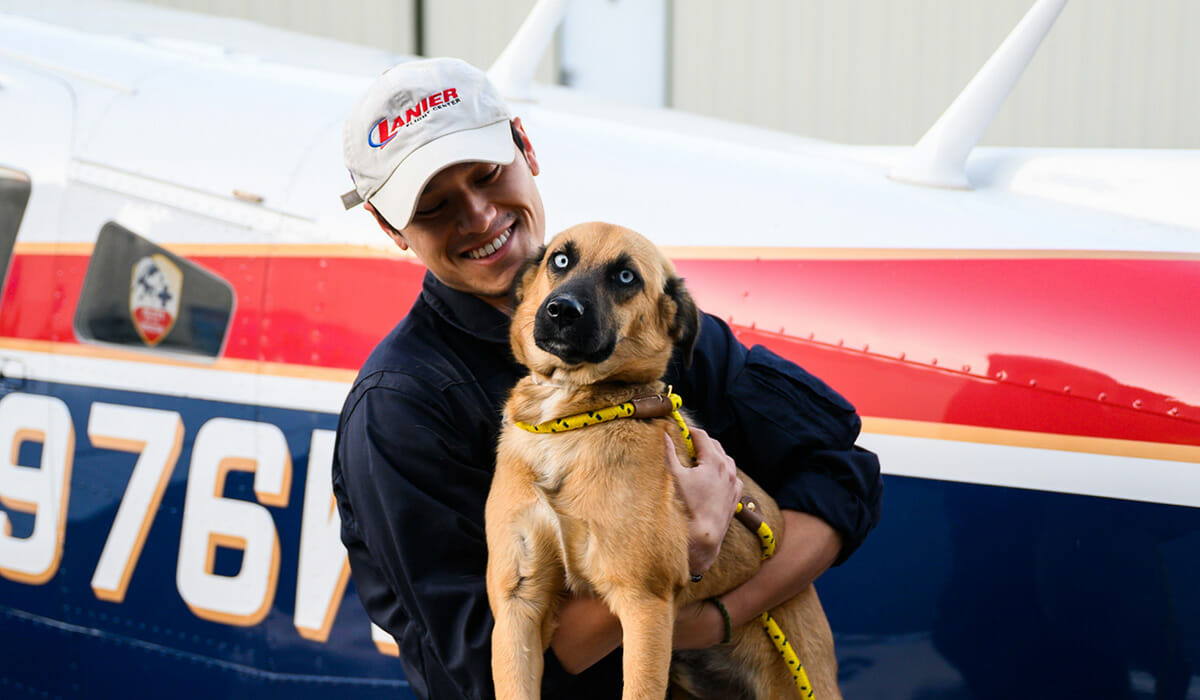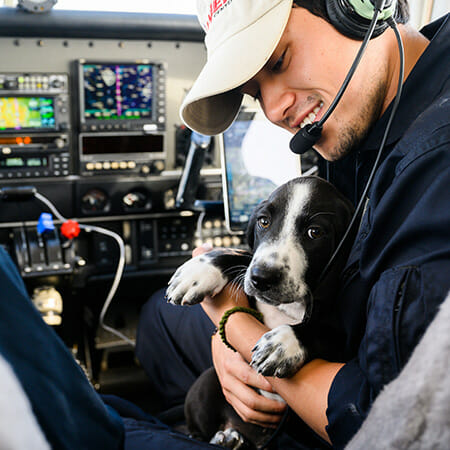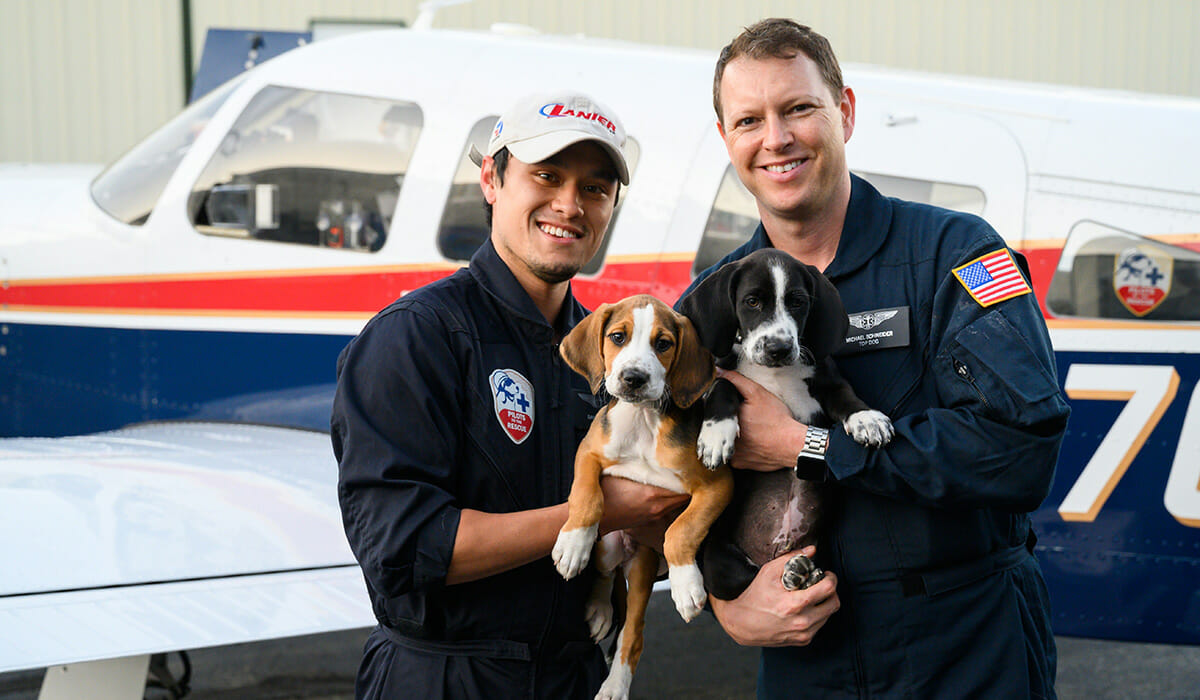Pilot Helps Rescue Animals In Need of Transport Around the Country

Meet Daily Point of Light Award honoree Daniel Bamuel. Read his story and nominate an outstanding volunteer or family as a Point of Light.
Daniel Bamuel has long been passionate about aviation, flying since he was around 13 years old and holding his pilot’s license since 2011. After hearing about a lot of rewarding service work that utilized flying, he started searching for a way he could volunteer in his New York area. This search led him to Pilots to the Rescue, a nonprofit aviation organization that transports domestic and endangered animals as well as people at risk. Daniel quickly connected with the nonprofit and its founder, Michael Schneider, and began volunteering in early 2019.
Since joining, Daniel has participated in dozens of flights and rescued hundreds of animals on the eastern seaboard. The animals rescued are predominantly dogs and cats, but Pilots to the Rescue has also saved wolves, turtles and fennec foxes. The nonprofit has also participated in angel flights, helping to transport families and individuals to medical appointments that they would not have the financial or logistical means to get to otherwise.
Describe your volunteer role with Pilots to the Rescue.
Pilots to the Rescue is a 501(c)(3) nonprofit. We rescue either endangered animals or animals that are in need of transport due to issues such as overpopulation in shelters, which is typically the biggest one, seizures, or puppy mills that are irresponsibly breeding. Pilots to the Rescue works with certain foster and shelter programs here in the tristate area and we try to transport animals from areas in the south that are typically having issues like that. Connecting the dot between the organizations down south that are trying to help these animals and transport them here, where they have a chance at fostering or adopting, is the goal there.

What inspired you to get involved with Pilots to the Rescue?
I had just moved back to New York from Oklahoma, where I was working and had gone to school. I had my pilot’s license and I heard about a lot of rewarding organizations that did good work with flying, so I thought to take a look and see what was around in New York. After a lot of searching, I came across Pilots to the Rescue, which at the time was a lot smaller in terms of footprint. I reached out to Michael Schneider. He’s the guy who had the dream of creating this organization. After a few emails back and forth, he said why don’t you come along on a rescue to see what it’s all about, so I came along on my first flight with him and the rest is history. It’s one of the most rewarding things you can do not only generally but also as a pilot. It’s a great way to combine your passion and love for aviation with rescuing animals, which as a dog owner, is a really nice and rewarding way to give back.
Why is it important for animals in need of transport to have an aviation option like Pilots to the Rescue?
There’s definitely debates we have had about how a van can certainly transport more animals in a given trip, but I think what we give them is time. A lot of dogs are in overcrowded shelters in the south, and a lot of times due to funding or the way the shelters are structured, they can’t always take in the volume of animals they get. Unfortunately, one byproduct of that is animals are euthanized when they’ve been in the system too long or they don’t have the room. If we can get that overflow out from that area into a shelter or foster program where that isn’t the ultimate end if they can’t get them out as soon as they’d like, then that’s what we give them, more than trying to get a van down to the area, as those areas can take a lot longer.
Have any of your flights been particularly memorable?
Generally the memorable part is the period after we land when volunteers show up at the airport and we start transporting animals. Each animal has it’s own way of handling the rescue. A lot are obviously nervous or stressed or maybe they poop or pee during the flight, and others are just taking in their journey. When we get to take them out of the crate and you can see they almost know something good is happening, I think that’s what’s rewarding for us — that moment we get to share with the animal, and especially hearing back afterwards about the outcome of the dog getting adopted or recovering from whatever medical illness they had. It’s hard to pinpoint one flight in particular, because they’re all so special, but it’s that moment when we take them out of the crates and we transfer them to the volunteers and we can see they’ve been through a stressful journey but they’re on to something better. If that’s all we get out of this, that’s all we could ever want.
Do you have any goals you would like to see Pilots to the Rescue accomplish?
A big limitation for us is the airplane itself, in that it has a limited range and limited speed, and most importantly, limited size in terms of its ability to carry crates. I think one of our few-years-out goals would be to get a larger airplane, which of course is contingent upon our ability to raise funds. We would love to eventually get a bigger plane that can allow us to travel farther and get more dogs in one time. Maybe one day we can do disaster relief flights and things like that. … We just want to continue getting bigger and better and hopefully can make an even bigger impact than we are now.

What’s been the most rewarding part of your work?
I think anyone who has or had a dog knows how special that animal can be in your life. Getting to be a critical part of that link where an animal’s ultimate end could be being put down, to now it being this amazing, unconditionally loving creature that can make a family that much better, I think is the most rewarding part to us. Our interaction with these animals is a fleeting few hours that we fly them back, but it’s knowing the impact this animal will now have, and not only having just saved it, but it’s going to be giving someone else this love for all these years. I think that’s why we do it.
What do you want people to learn from your story?
One thing we always talk about is it’s not work if you love what you do. Certainly there are days where it’s extremely exhausting going on a full-day flight that starts at four in the morning and we get back very late at night. If you love what you do, it’s not really work. I think that’s one thing we’ve come to really appreciate. On an animal front, of course we love to say if you can adopt instead of buying a dog, that is doing a tremendous service to these animals and the community as a whole, if that’s something you can afford to do. Even if you can’t take on that responsibility, because I realize that’s a lot, if you can volunteer at local shelters and help spread awareness, that’s a small drop in the bucket but extremely helpful. Do whatever you can to support the cause, and that’s all we can ask for.
Do you want to make a difference in your community like Daniel? Find local volunteer opportunities.
